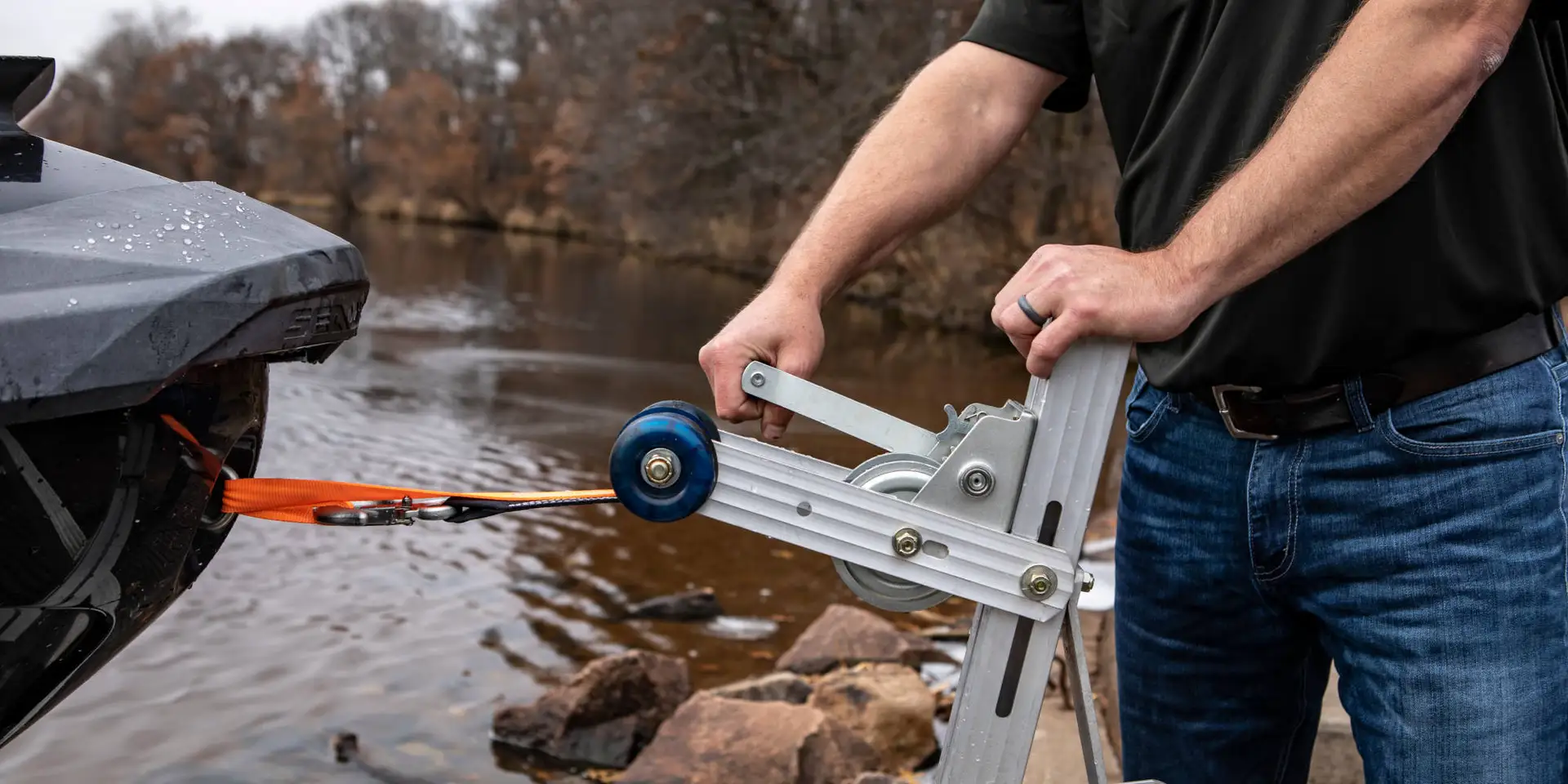

Winch Wisdom: How to Find the Best Type of Winch for Your Needs
What is a winch? For off-road enthusiasts, boaters, and DIY hobbyists alike, winches are the unsung heroes of heavy lifting and pulling. From hauling a stuck truck out of the mud to pulling a boat onto a trailer, the right winch can make all the difference.
Factors like pulling capacity, power source, and rope, strap, or cable material play a crucial role in determining which winch will be most effective for your task. Additionally, the environment in which you'll be using your winch — whether on rocky trails, in marine settings, or on the worksite — will influence your decision. But how do you choose the best winch for your specific needs? In this guide, we’ll break down the essentials of winches, explore different types of winches, and help you understand the ins and outs of how winches work.
- What is a winch?
- Parts of a winch
- How does a winch work?
- Winch vs. hoist
- Pulling vs. lifting winch
- Common types of winches
- Winch Accessories & replacement parts
- Winch FAQ
What is a Winch?
At its core, a winch is a device designed to wind or unwind a cable or strap, usually to pull or lift a heavy object. Winches come in various forms, from manually operated hand-crank models to powerful electric-powered versions, each tailored to meet the demands of specific tasks.
Winches are a staple across multiple industries, including towing, construction, off-roading, and marine applications. But they aren’t just for professionals — many homeowners and hobbyists find winches invaluable for projects like clearing fallen trees or hoisting equipment in a garage. Winches also come equipped with different types of leads, like steel cables for maximum strength or synthetic lines for flexibility and reduced weight.
With technological advancements, modern winches are more efficient, durable, and easier to operate than ever, often featuring wireless remote controls, waterproof housings, and automatic braking systems to ensure safety and ease of use. Regardless of your needs, the right winch can significantly reduce manual labor, increase productivity, and enhance safety. Understanding how winches work, and which type is best for your task can make all the difference in choosing a reliable tool that gets the job done right.
Parts of a Winch
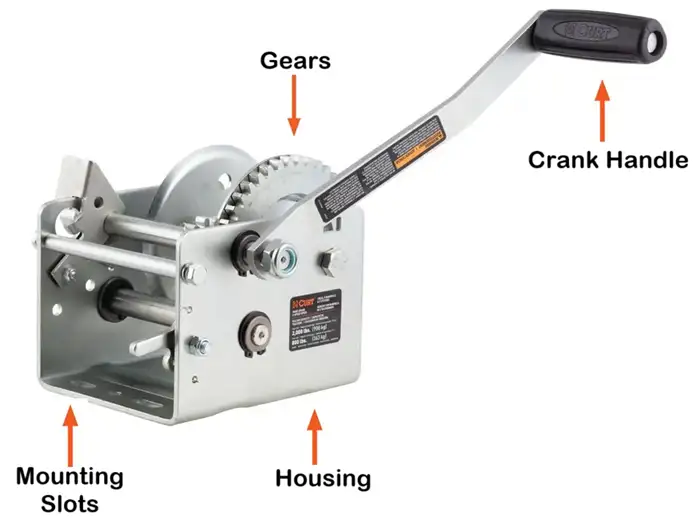

To understand how a winch operates, it’s essential to be familiar with its key components. The components of a winch include several key parts that work in tandem to generate pulling or lifting power. While electric and manual winches may differ slightly, the fundamental parts remain the same.
Key Parts of a Manual Winch
- Crank Handle: The handle is used to manually turn the drum. As the user turns the crank, the winch winds or unwinds the cable or strap.
- Drum: A cylindrical spool where the cable or rope is wound. The drum rotates to either reel in or let out the line.
- Cable/Rope: The pulling line, which can be a steel cable for strength and durability or a synthetic rope for lighter weight and flexibility.
- Gear Train: A series of gears that provide mechanical advantage, making it easier to lift or pull heavier loads. Common gear types include worm gears or spur gears, which control the speed and torque of the winch.
- Ratchet or Brake System: This component locks the input shaft in place when the user stops turning the handle, preventing the line from slipping back and keeping the load secure.
- Frame or Housing: The frame holds the winch components together and can be mounted to a fixed point such as a trailer or anchor point.
Hook or Attachment Point: The end of the cable or strap is typically equipped with a hook or another attachment mechanism, allowing it to be securely fastened to the load being moved.
Additional Parts of an Electric Winch
- Motor: The motor powers the winch and can be electric or hydraulic depending on the winch type.
- Fairlead: A guide that ensures the cable or rope feeds smoothly onto and off the drum, reducing wear and preventing tangling. It can be a roller fairlead (used with steel cables) or a hawse fairlead (typically used with synthetic ropes).
- Solenoid: This acts as an electrical switch, directing current from the battery to the winch motor when activated, controlling the winch’s operation.
- Control System: Can be a wired or wireless remote that allows the user to control the winch, often featuring buttons for powering in or out and, in more advanced models, variable speed control.
- Clutch: The clutch mechanism allows the winch to be engaged or disengaged. When disengaged, the drum is free-spooling, allowing you to manually pull out the line without using the motor.
Together, these components create a powerful machine capable of handling a wide range of heavy-duty pulling and lifting tasks.
How Does a Winch Work?
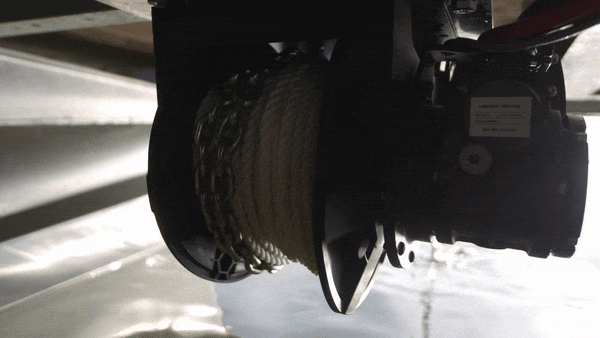

At the heart of any winch’s operation is the concept of gear ratios. Gear ratios refer to the relationship between the rotational speed and the amount of torque produced. So in simple terms, a winch works by slowing down the energy you put in (speed) and turning it into a lot more pulling / lifting force (torque), which allows it to lift or pull heavy objects that would otherwise be impossible to move. Think of it like riding a bike in low gear — you pedal more, but it’s easier to climb hills.
Wheel & Axle Science
The basic science behind winches involves simple machines. The drum acts like a wheel, while the cable acts as the axle. By rotating the drum, the cable wraps around it, allowing the winch to exert force on whatever it’s connected to. It’s as simple as that.
How Does a Winch Operate?
A heavy duty winch works on the basic principle of converting energy (either manual or motorized) into pulling power by using gear ratios to increase torque. Here's a simple breakdown of how it operates:
- Turning Energy into Motion: Whether you're cranking a manual handle or powering an electric motor, that initial energy starts the process. This energy needs to be converted into torque, which is the force required to move heavy objects.
- Gear Ratios: The winch uses a system of gears to take the energy you're putting in and multiply it. In a winch, the gears reduce the speed of the motor or crank, which might be spinning quickly, and convert that speed into increased torque. The higher the gear ratio, the more pulling force the winch generates. For example, a gear ratio of 200:1 means that for every 200 revolutions of the motor or crank, the winch drum rotates once, significantly increasing the pulling force.
- Drum and Cable: The drum is the spool that holds the cable or rope. As the gears turn the drum, the cable wraps tightly around it. The tension created by this winding process is what pulls the heavy object towards the winch.
- Pulling Power: The increased torque from the gear ratio means that the winch can pull much heavier loads than the input energy alone would suggest. This is how even a small electric motor or hand crank can move very large, heavy objects.
Winch vs. Hoist: What's the Difference?
Though often used interchangeably, winches and hoists serve different functions. If you're dragging something horizontally, you’d likely use a winch, whereas for vertical lifting, a hoist is the right tool for the job. In the simplest terms, winches are for pulling and hoists are for lifting.
- Winches are designed primarily for pulling heavy objects horizontally across a surface or up an incline. It is commonly used for off-road vehicle recovery, pulling boats onto trailers, or moving heavy loads over flat ground.
- Hoists are specifically built for lifting and lowering loads vertically. It's commonly used in construction, warehouses, and industrial settings to raise materials or equipment up and down.
Can you use a winch for lifting? In some cases, yes — but it’s essential to check the manufacturer’s guidelines. Winches used for lifting should have built-in brakes to prevent the load from dropping if the handle slips or the power cuts out.
Pulling Winch vs. Lifting Winch
Winches are versatile tools that come in various forms, each designed for specific tasks and applications. There are two primary categories of winches based on their use: pulling winches and lifting winches. Each has its variations and subtypes, which we will explore below.
Pulling Winches
Pulling winches are designed primarily for horizontal movement, making them ideal for tasks such as vehicle recovery and towing. Within this category, the two-speed pulling winches stand out, offering flexibility in both power and speed.
- Two-Speed Pulling Winches: These winches allow operators to switch between high-speed retrieval and low-speed, high-torque operation, providing the versatility needed for various scenarios.
Lifting Winches
Lifting winches are specifically engineered for vertical movement, making them ideal for applications where precise control is essential. The most notable feature of lifting winches is their braking systems, which ensure safety and stability while lifting loads.
- Brake Systems: The brakes in these winches are designed to hold loads securely in place, making them a safer option for lifting heavy materials on construction sites or in industrial settings.
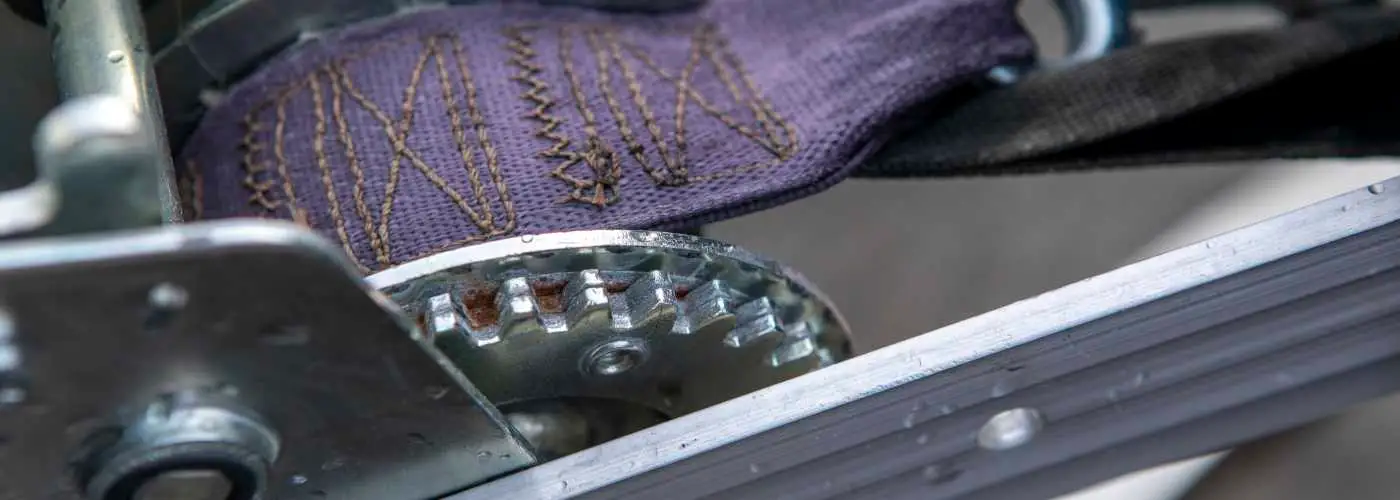

Common Types of Winches
Beyond the basic categories of pulling and lifting winches there are several subtypes of winches that cater to specific applications. Here’s a closer look at some of those other type of winches.
1. Manual Winches
Any winch that’s hand-cranked falls into this category, and they can be either pulling or lifting winches. Manual winches are operated by hand and are known for their simplicity and portability which make them great for a variety of tasks. Available in a range of weight capacities, manual winches can handle loads from lighter applications to more substantial lifting tasks. They also include variations with straps and heavy-duty cables so you can rest assured you have the right setup for your specific need.
2. Electric Winches
Electric winches are powered by electricity and can function as either pulling or lifting winches. With just the push of a button, they can pull or lift heavy objects with ease. They are ideal for users who require less manual effort and faster operation, making them perfect for off-road recovery, industrial lifting tasks, and more.
3. Boat Winches
Boat winches are crucial for ensuring smooth and efficient operations on the water, and they come in various types to suit your specific needs.
Standard Boat Winches
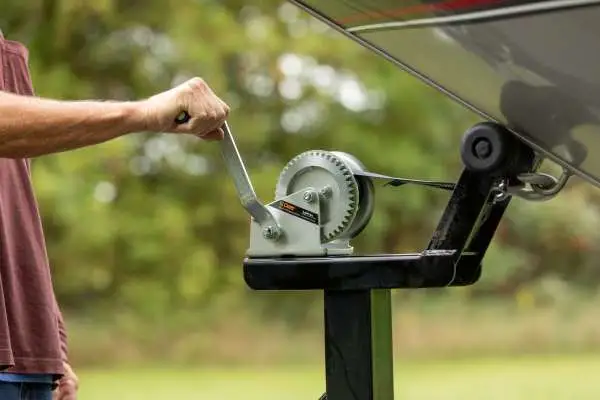

A standard boat winch is an essential tool for any boater and they’re primarily used to pull boats out of the water and onto a trailer. Standard boat winches are built to handle a wide range of boat sizes and weights and feature either a durable steel cable or synthetic strap for easy loading and unloading.
Jet Ski Winches
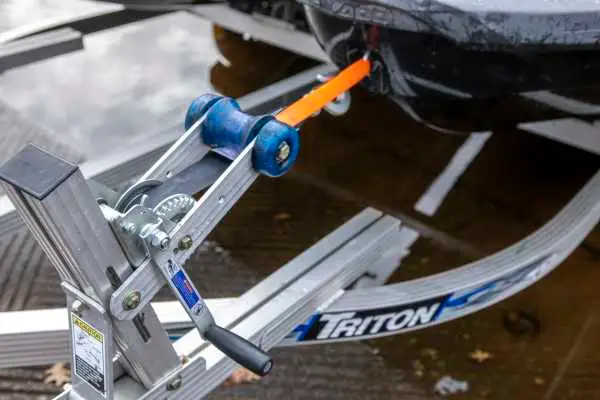
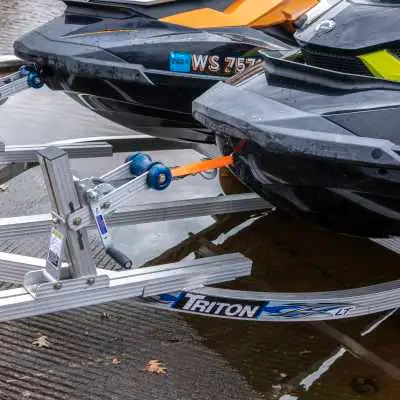
Jet ski winches are similar to boat winches in that they’re both used for launching and loading your personal watercraft onto a trailer. These winches are typically mounted onto a trailer and they will have an extra bow loop sewn into the winch strap to aid in connecting to various types of connection points found on most jet skis.
Anchor Winches
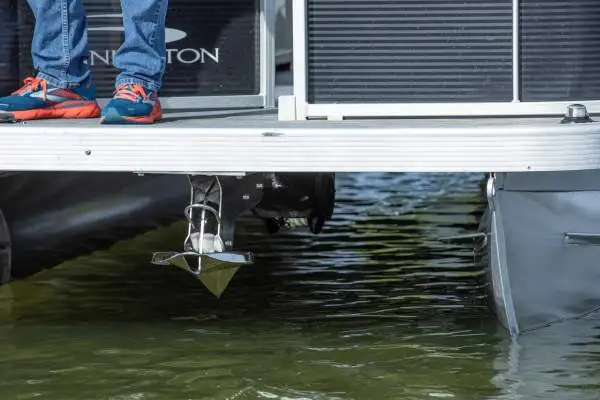

Anchor winches are vital tools that simplify the challenging task of deploying and retrieving an anchor. Designed to handle the specific demands of mooring, these winches automate the anchoring process, allowing for smooth and efficient operation at just the push of a button. They play a crucial role in ensuring safe and efficient anchoring, allowing boaters to secure their vessels quickly and effectively in various marine environments.
Sail Winches
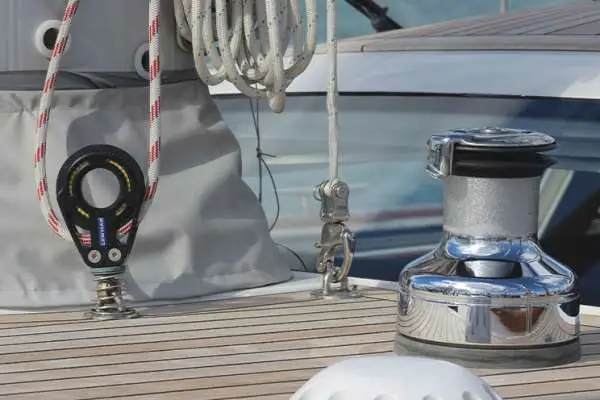

Sail winches are specialized devices designed to assist sailors in controlling and adjusting the sails of a sailing vessel. These winches provide the mechanical advantage needed to handle the significant forces generated by the sails, making it easier to trim, raise, and lower them while sailing.
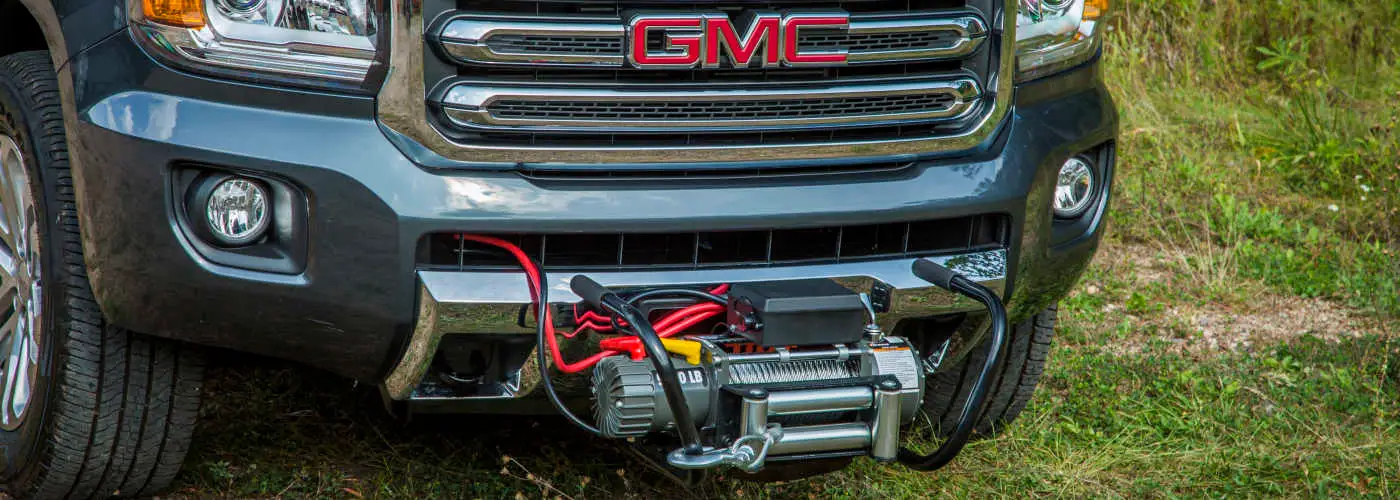

4. Hitch-Mounted Winches
Hitch-mounted winches are handy tools that attach directly to a vehicle's receiver hitch, making them great for towing and pulling tasks. These winches are perfect for both off-road enthusiasts and everyday drivers, as they can help recover vehicles that get stuck in mud, snow, or other difficult conditions. They are easy to install and can be quickly removed when not needed.
5. Grille-Guard-Mounted Winches
Grille-guard-mounted winches are specialized winches that attach directly to the grille guard of a vehicle, providing a rugged solution for off-road recovery and towing. These winches are designed to withstand tough conditions and are often used by off-road enthusiasts who need reliable pulling power in challenging environments. By mounting the winch on the grille guard, it remains easily accessible and maximizes the vehicle's approach angle, making it ideal for navigating obstacles.
6. Bumper-Mounted Winches
Bumper-mounted winches are powerful tools that are installed directly onto the front bumper of a vehicle, providing an efficient solution for recovery and towing tasks. These winches are designed for off-road enthusiasts and those who frequently face challenging terrains, such as mud, sand, or snow. By mounting the winch on the bumper, it stays protected and maintains the vehicle's overall aesthetic while remaining easily accessible for use.
Winch Accessories & Replacement Parts
Over time, you may need to replace parts or add accessories to your winch to maintain optimal performance. Here are some key winch accessories:
- Straps: Perfect for securing loads and often an alternative to steel cables.
- Cables: Steel or synthetic cables are vital for winch operation and can wear out over time.
- Receiver Mount: Allows you to attach a winch to a vehicle’s hitch.
- Winch Plate: Secures the winch to a vehicle or mounting surface.
- Fairlead: Guides the winch cable and reduces wear.
- Replacement Handle: Essential for manual winches if the handle is lost or damaged.
Frequently Asked Questions About Winches
What is a Winch?
A winch is a tool that helps you pull or lift heavy things. It uses a strong cable, rope, or strap that wraps around a drum, and when you turn a handle or press a button, it pulls in the rope to move the object. People use winches for tasks like pulling a car out of the mud, lifting heavy objects, or loading a boat onto a trailer. It's like having super strength to move something that would be too hard to do by yourself!
How Does a Winch Work?
A winch works kind of like a fishing reel! Imagine you have a strong rope wrapped around a spool (a round drum). When you turn a handle or press a button, the winch pulls in the rope, just like when you reel in a fish. The winch uses a motor (or your hand power) to make the spool spin, which winds the rope and pulls the heavy thing towards you.
A winch gives you extra strength, so even if the object is really heavy, like a stuck car or a big boat, the winch makes it easier to move. The winch also has special gears inside, like a bike’s gears, that help it pull even harder when needed, but slower to stay in control.
How Do You Use a Winch?
To use a winch, first inspect the equipment, including cables and hook, and select a stable anchor point. Pull out the cable, attach it to the anchor, and engage the winch clutch. Slowly operate the winch while maintaining clear communication and staying clear of the cable. Use safety gear, such as gloves and a winch dampener, to prevent injury. Avoid overloading the winch and ensure even winding of the cable onto the spool.
What Size Winch Do I need?
To choose the right winch size, calculate the total weight of the vehicle or object you need to recover. A common guideline is that the winch's rated capacity should be at least 1.5 times the gross vehicle weight (GVW). For example, if your vehicle weighs 5,000 lbs, you’ll need a winch rated for 7,500 lbs or more. Consider the terrain, potential obstacles, and usage frequency. For heavy-duty or extreme off-road use, opting for a higher capacity winch offers better reliability and safety.
Can a Winch be used as a Hoist?
Technically, a winch can sometimes be used as a hoist, but it's not recommended for most situations. Pulling winches are designed for pulling heavy loads horizontally (like dragging a car or boat), not for lifting objects vertically. Lifting winches or hoists are specifically made for lifting heavy loads straight up and down. They come with extra safety features, like strong brakes, to prevent the load from dropping.
While some pulling winches may have the power to lift, they typically lack the proper braking systems and safety mechanisms that hoists have. So, if you need to lift something vertically (like in construction or to suspend heavy objects), a hoist or lifting winch is the safer and better choice.
 ARIES
ARIES  CURT
CURT  LUVERNE
LUVERNE  UWS
UWS 


